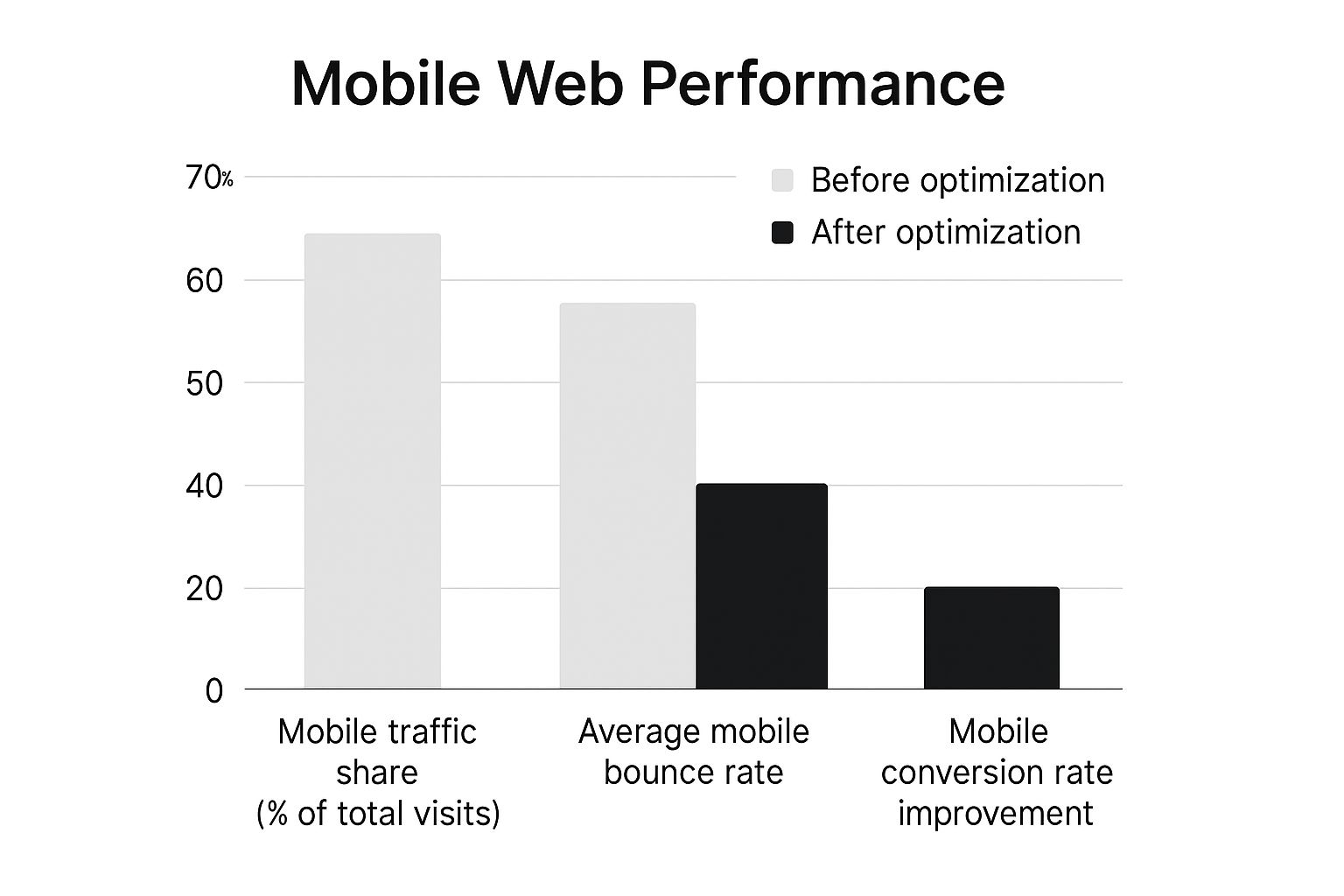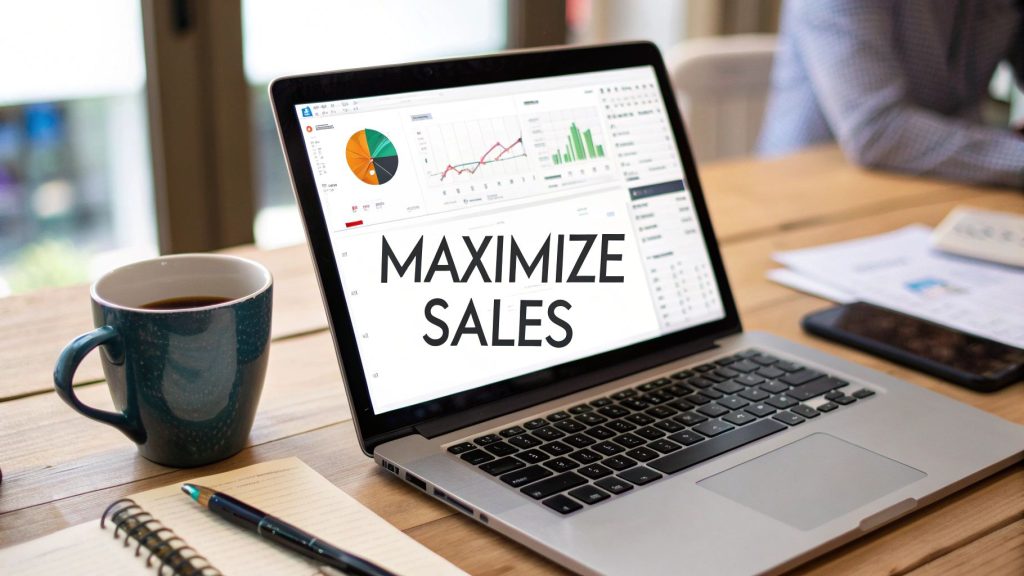Understanding What Actually Drives Ecommerce Success

When you're trying to figure out how to optimise an ecommerce website, it’s easy to get lost in an endless list of technical tasks. You'll see advice to minify code, compress images, add trust badges, or change button colours. While this advice isn't wrong, it often overlooks the most important factor: what actually convinces a person to click "add to cart" and follow through with a purchase. Before you get lost in the details, it's vital to grasp what truly fuels success, which can be explored further in these 10 proven strategies to increase ecommerce sales.
The best online stores don't just follow checklists; they are experts in shopping psychology. They recognise that buying is often an emotional choice that we later justify with logic. These stores don't just sell items; they sell solutions, renewed confidence, and an improved version of the customer's life. This means every single change, from the text on a product page to the design of the checkout, is carefully planned to reduce customer anxiety and build excitement. Instead of simply making a button bigger, they ask, "What's stopping someone from clicking this right now?" This change in thinking is what separates stores that are just getting by from those achieving massive growth.
Pinpointing Your True Conversion Killers
Many shop owners think their main issue is a lack of traffic, but more often than not, the problem is a leaky bucket. You can drive all the traffic in the world to a site with core user experience problems, and you'll just be wasting your marketing funds. The real work lies in finding the specific bottlenecks where potential customers lose their confidence and decide to leave.
These issues are often subtle and tied directly to human behaviour:
- Decision Paralysis: Are you presenting too many options without any clear direction? A visitor looking at 50 similar coffee makers might just give up and head to a competitor that offers a curated "Best for Espresso" collection.
- Unanswered Questions: Does your product page leave a crucial doubt unresolved? If a customer is wondering about the return policy for a shirt and can't find that information quickly, that small bit of friction is frequently enough to lose the sale.
- Lack of Social Proof: People often look to others to guide their purchasing decisions. A product page with no reviews feels risky, whereas one with genuine feedback feels like a much safer and more reliable choice.
Aligning Optimisation With Shopping Psychology
Every adjustment you make should directly address a psychological trigger. For example, rather than just adding a security badge because a guide recommended it, consider the customer's underlying fear: "Is my payment information safe on this site?" You can tackle this fear not only with a badge but also with a professional design, transparent pricing, and easily accessible contact information.
This focus is particularly important in fast-growing regions. The MENA ecommerce market, for instance, is forecasted to reach $57.8 billion by 2029, presenting a huge opportunity for businesses. However, this growth also brings more competition and more discerning customers who expect trustworthy and effortless experiences. Optimising for this market is not just about site speed; it's about building a brand that connects with local consumer habits and establishes solid trust. You can learn more about these market developments by reading the full report on MENA ecommerce growth. By concentrating on the 'why' behind what your customers do, you can make smarter decisions that lead to lasting success.
Building Mobile Experiences That People Actually Buy From
Thinking of your mobile site as just a shrunken-down version of your desktop site is one of the most common mistakes in e-commerce today. The reality is that shopping on a mobile device is a completely different world. Users are often distracted, using one hand (usually their thumb), and have far less patience for slow-loading pages or confusing navigation. To truly learn how to optimise an e-commerce website, you must first master the mobile experience, as this is where a huge portion of your customers will make their final buying decision.
Mobile commerce is no longer a small fraction of sales; it's a dominant force. This is especially true in rapidly growing markets. In the UAE and the wider MENA region, mobile commerce commands a significant share of all online sales. This means that stores without a seamless mobile journey are leaving a massive amount of revenue on the table, as optimised sites see much higher engagement. You can explore more about this trend and its impact by reviewing the latest analysis of the Middle East and Africa e-commerce market. The takeaway is clear: if your mobile site doesn’t convert, your business is at a serious disadvantage.
This infographic clearly illustrates the direct benefits of prioritising the mobile experience, from traffic volume to bounce rate reduction.

The data shows that while mobile drives a majority of traffic, targeted optimisations are what turn those visits into sales, dramatically lowering bounce rates and boosting conversions.
To help you prioritise, here's a checklist that compares various mobile optimisation techniques. We've ranked them by how difficult they are to implement against their potential impact on your conversion rates, giving you a clear path forward.
| Mobile Optimization Checklist: Performance vs. Conversion Impact |
| :— | :— | :— | :— |
| Optimization Technique | Implementation Difficulty | Conversion Impact | Priority Level |
| Implement Thumb-Friendly Navigation | Low to Medium | High | High |
| Simplify Checkout Forms | Medium | Very High | High |
| Integrate Digital Wallets (Apple/Google Pay) | Medium | Very High | High |
| Add Visual Progress Indicators to Checkout | Low | Medium | Medium |
| Optimise Product Images for Mobile | Low | Medium | Medium |
| Enable Guest Checkout | Low | High | High |
| Improve Mobile Page Load Speed | Medium to High | High | High |
| Use a Sticky Bottom Menu Bar | Low | Medium | Medium |
This checklist makes it clear: focusing on checkout simplification and integrating digital wallets offers the highest return for a moderate amount of effort. These should be at the top of your to-do list to stop leaving money on the table.
Designing for Thumbs, Not Cursors
The first principle of a great mobile experience is designing for how people actually hold and use their phones. This concept is often called "thumb-friendly" design. Imagine a user holding their phone in one hand; their thumb has a natural, comfortable range of motion. Critical elements like navigation menus, "add to cart" buttons, and search bars should be placed within this easy-to-reach zone, typically at the bottom or middle of the screen.
High-converting mobile sites often use a sticky bottom navigation bar that includes icons for home, search, cart, and account. This simple change prevents users from having to awkwardly stretch their thumb to the top corner of the screen to navigate, which is a small point of friction that can cause them to abandon their session. Every tap should feel effortless.
Streamlining the Mobile Checkout Funnel
The mobile checkout process is where most sales are lost. A desktop checkout form with multiple fields and steps might be manageable with a keyboard and mouse, but it’s a conversion killer on a small touchscreen. The goal here is ruthless simplification.
Here’s how top-performing stores achieve this:
- Minimal Form Fields: Only ask for the absolute essentials. Do you really need their phone number if you're not going to use it for delivery updates? Use autofill features for addresses wherever possible.
- Guest Checkout Prominence: Forcing a user to create an account before they can buy is a major barrier. Make the guest checkout option the most obvious and easiest path forward.
- Visual Progress Indicators: Show users where they are in the process (e.g., Shipping > Payment > Review). This manages expectations and reduces the anxiety of a seemingly endless checkout.
- Digital Wallet Integration: This is non-negotiable. Integrating payment options like Apple Pay and Google Pay allows customers to complete a purchase with a single tap or facial scan. It bypasses the tedious process of manually entering credit card details, which is a huge friction point on mobile. A customer who sees they can pay with a trusted, one-click method is significantly more likely to finalise their purchase.
By focusing on these practical, user-centric improvements, you move beyond basic responsive design. You start building a mobile experience that anticipates the user's needs, removes friction at every step, and ultimately convinces them to complete their purchase right then and there.
Speed Optimisation That Actually Moves The Revenue Needle

When you explore ways to improve your e-commerce website, you’ll quickly realise site speed is a major focus. Most advice follows a familiar script: compress your images, minify your CSS and JavaScript files, and enable browser caching. While these technical checks are valid, they don't always create a better experience for the customer, and more importantly, they don’t always increase sales. The real objective isn't to get a perfect score on a speed test; it's to make changes that your customers feel and that directly grow your revenue.
Honestly, your customers don't know or care about your Time to First Byte or the number of DOM elements on your page. What they do care about is how fast they can see the product they want and how smoothly they can get through the checkout. A tiny one-second delay in page load time can lead to a 7% drop in conversions. This means that focusing on changes that improve the perceived speed of your most important pages—like product and checkout pages—provides a much bigger return than just chasing technical scores.
Prioritising Speed Fixes That Boost Sales
Instead of viewing all speed improvements as equal, it's much smarter to prioritise them based on how they might influence customer actions. Not all slowdowns have the same impact. A slow-loading blog post is annoying, but a slow-loading "add to cart" button is a direct cause of lost money. Your attention should be on the parts of your site that are essential to the buying journey.
A great first move is to run your site through a performance tool to get a clear picture of where your main slowdowns are.

This kind of report shows key performance indicators like Largest Contentful Paint (LCP), which measures how long it takes for the main content on your page to show up. A high LCP score has a direct, negative effect on a user's sense of speed.
Using information from tools like this, you can build a focused plan. Here are a few high-impact areas to concentrate on:
- Image Optimisation on Product Pages: Large, uncompressed images are frequently the number one reason for slow product pages. Use modern image formats like WebP, which provides much better compression than older formats like JPEG and PNG. Also, be sure to implement lazy loading, which ensures images further down the page only load when a user scrolls to view them.
- Database Performance: If your product search or filtering feels sluggish, it could point to a database problem. Regularly clean out old data, such as expired orders or unused product variants, and make sure your database queries are running efficiently. This is especially crucial for stores with large product catalogues.
- Third-Party Scripts: Chat widgets, analytics tools, and social media pixels can add serious drag to your site's load time. Go through all your third-party scripts and get rid of any that are not absolutely essential. For the ones you decide to keep, use an asynchronous loading method so they don’t stop the rest of your page from rendering. You can also get more detailed information by checking out our complete guide on website speed optimisation.
By changing your focus from abstract scores to real improvements in user experience, your speed optimisation efforts will begin to contribute directly to your bottom line.
Creating Trust That Converts Skeptical Visitors Into Customers
Beyond site speed and mobile-friendliness, a massive piece of the puzzle for e-commerce optimisation is building genuine customer trust. This isn't about just slapping a few security logos in your footer and calling it a day. Real trust is woven into the entire user experience, making shoppers feel secure and confident from the moment they arrive until they click "buy."
Let's face it, scepticism is the default setting for most online shoppers. They're silently asking, "Is this site legit? Is my product actually going to show up? Can I trust them with my credit card number?" The most successful online stores anticipate these anxieties and tackle them head-on with smart design and clear communication, turning doubt into confident purchases.
Building Confidence Beyond Security Badges
Of course, you need the basics like SSL certificates and recognisable payment logos. But in today's market, those are just the price of entry—customers simply expect them. To really make an impact, you have to build trust in more powerful, if subtle, ways. It all starts with how you present your products. High-quality, original product photos are an absolute must. Grainy, generic stock images are a major red flag for shoppers.
The work doesn't stop once the photos are taken. The post-production process is just as important for making your products look their best. Using professional photo editing services for e-commerce can ensure your images are sharp, consistent, and accurately show what the customer will receive. This level of detail communicates professionalism and shows you care about your products and your customers.
Another powerful way to build trust is through detailed and honest product descriptions. Don't just list a few features; get ahead of your customers' questions.
- What materials is it made from?
- What are the precise dimensions?
- Are there any special care or cleaning instructions?
- What is the return policy for this specific item?
Answering these questions upfront shows you understand what shoppers are thinking and helps prevent future frustration. It builds a layer of confidence that a simple security icon never could.
Social Proof and a Secure Checkout Experience
People naturally look to others to figure out what to buy and where to buy it. That's why social proof is one of the most effective tools for building trust. Displaying real customer reviews and ratings directly on your product pages is non-negotiable. Research shows that over 90% of consumers read reviews before making a purchase, and they often trust them as much as a recommendation from a friend.
This trust needs to be maintained right through to the final, critical stage: the checkout. A clunky, confusing, or unprofessional-looking checkout page can destroy all the confidence you've worked so hard to build. Your checkout page should be clean, clearly branded, and free from distracting pop-ups or navigation. Show the total cost, including any shipping or taxes, upfront—no last-minute surprise fees.
Every element should feel secure and straightforward, reinforcing the customer's decision to buy from you. To see how these trust signals stack up against each other, we've analysed their relative impact.
Trust Signal Effectiveness: Customer Impact Analysis
Data-driven analysis of various trust signals and their measured impact on conversion rates and customer confidence
| Trust Signal | Implementation Cost | Conversion Impact | Customer Confidence Boost |
|---|---|---|---|
| High-Quality Product Photos | Medium | High | High |
| Detailed Product Descriptions | Low | Medium | High |
| Customer Reviews & Ratings | Low to Medium | Very High | Very High |
| Secure Checkout (SSL/Badges) | Low | High (essential) | High |
| Clear Return Policy | Low | Medium | High |
| Professional Site Design | Medium to High | High | Very High |
The data is clear: while foundational security is essential, signals like genuine reviews and professional visuals have a massive impact on both confidence and conversions.
Ultimately, a trustworthy site is one that respects the customer's time and money, making them feel valued and secure throughout their entire shopping journey. This is where your brand's reputation becomes a key asset. Considering how online reputation management services can help manage and bolster your brand's image across the web can be a very worthwhile investment.
SEO That Brings In Customers Ready To Buy

When you're trying to figure out how to optimise an e-commerce website, it's tempting to chase big traffic numbers. But more visitors don't always translate into more sales. Smart e-commerce SEO isn't about casting the widest net possible; it's about attracting shoppers who are ready to buy. The real goal is to drive high-quality, high-intent traffic that boosts your revenue, not just your analytics dashboard. This means your focus should shift from just ranking high to ranking for the specific phrases that signal a customer is close to making a purchase.
This journey begins with understanding a customer's search intent. For instance, someone searching for "best running shoes" is still in the research phase. But a person searching for "buy Nike Air Zoom Pegasus 40 size 11" is on a mission. Your SEO strategy needs to cater to both, guiding users smoothly from their initial research to the final purchase. This involves organising your site in a way that’s logical for both people and search engines, using clear category pages and detailed product pages that answer every question a potential buyer might have.
Focusing Keyword Research on Commercial Intent
The core of a strong SEO plan is keyword research, but for an e-commerce store, you need to add a crucial filter: commercial intent. These are the words and phrases people type into Google when they’re ready to spend money. Instead of only targeting broad, high-traffic terms, you need to find the specific phrases that lead directly to sales.
Think about the different stages of a customer's journey:
- Problem-Awareness Keywords: "comfortable office chair for back pain"
- Comparison Keywords: "Herman Miller Aeron vs Steelcase Leap"
- Product-Specific Keywords: "buy Herman Miller Aeron graphite"
- Brand + Purchase Keywords: "Herman Miller sale UAE"
Targeting these longer, more specific keywords, often called long-tail keywords, is usually more effective because they attract shoppers who are much closer to buying. A great starting point is to see what search queries are already bringing people to your site. Tools like Google Search Console are perfect for this.
Here's an example of what that performance report might look like.

This report shows you the exact terms people use to find your pages. It can help you spot queries with high impressions but low clicks, which are prime candidates for better optimisation.
Optimising Product and Category Pages
Once you have your list of commercially-focused keywords, it’s time to put them to work on your most important pages: your product and category pages. Think of these as your digital storefronts; they need to be appealing to both search engines and your customers.
For Category Pages:
- Write helpful, unique descriptions. Don't just show a grid of products. Add a 100-200 word introduction at the top. Explain what the category is about and help guide the user. For a "Men's Hiking Boots" page, you could briefly touch on the differences between lightweight trail shoes and heavy-duty mountaineering boots.
- Use clean, keyword-rich URLs. A URL like
yourstore.ae/mens-footwear/hiking-bootsis far more effective and user-friendly than something likeyourstore.ae/cat?id=123. - Implement smart filtering. Let your customers filter products by size, colour, brand, price, and other key features. This not only improves their experience but also creates specific, indexable URLs that can capture very precise long-tail searches.
For Product Pages:
- Write compelling, original descriptions. Avoid just copying and pasting the manufacturer's description. This can create duplicate content issues with other retailers. Instead, write your own copy that highlights the product's benefits, tells a story, and uses your target keywords in a natural way.
- Use high-quality images with descriptive alt text. Your alt text should clearly describe the image for visually impaired users and for search engines (e.g., "front view of a black Nike running shoe").
- Use structured data (Schema Markup). This is a bit of code that helps search engines understand your page’s content more deeply. It’s what enables rich snippets in search results, showing details like price, stock availability, and review ratings right on the results page. Studies have shown that pages with rich snippets can see a 20-30% increase in click-through rates.
For small businesses getting started, getting these SEO fundamentals right is crucial. You can find more practical advice for building a strong online presence in our guide on SEO for small business. By making sure your SEO efforts align with how people actually shop, you build a reliable engine for long-term revenue growth.
Personalisation That Increases Average Order Values
A generic, one-size-fits-all shopping experience just doesn’t connect with customers anymore. People are used to the smart, relevant suggestions they get from major online retailers, and they now bring that expectation to every store they visit. This shift is a key part of learning how to optimise an e-commerce website for today's shopper. By using customer data intelligently, you can design experiences that feel more personal and actively encourage shoppers to add more to their carts.
The good news is you don't need a massive budget like Amazon to get started. Effective personalisation begins with understanding your audience and grouping them in a logical way—a process known as audience segmentation. This helps you move past sending the same email blast to everyone and instead deliver targeted messages that speak directly to specific customer habits and tastes. This focused approach makes customers feel seen and understood, which builds loyalty and boosts their average spend over time.
Practical Segmentation for Real Results
You can begin segmenting your audience using simple, accessible data points. The objective is to create distinct groups you can market to with greater precision. A few highly effective segments include:
- High-Spenders: These are customers with a high average order value (AOV). You can target this group with exclusive early access to new collections or special "VIP" discounts to make them feel valued.
- Frequent Buyers: These shoppers purchase from you regularly but might have a lower AOV. Encourage them to spend more with offers like "buy three, get one free" or by recommending products that complement their usual purchases.
- First-Time Customers: Welcome them with a special introductory offer for their second purchase to help turn them into repeat buyers. A simple 15% discount on their next order can be incredibly persuasive.
- Abandoned Cart Users: These shoppers were on the verge of buying. A timely reminder email, perhaps sweetened with an offer like free shipping, can often be the nudge they need to complete the sale.
Once you establish these segments, you can adjust everything from your email campaigns to the product recommendations they see on your site, making each interaction more relevant.
Making Product Recommendations That People Actually Click
One of the most powerful personalisation tools is the product recommendation engine. When used correctly, it can give your average order value a significant lift. Instead of just displaying random "popular products," you can show items that are genuinely helpful to the person currently browsing.
Consider these tactical recommendation styles:
- "Frequently Bought Together": On a product page for a new laptop, you could recommend a protective sleeve and a wireless mouse. This is a classic cross-selling technique that works because it adds real value for the customer.
- "Complete the Look": For a fashion store, if a customer is looking at a pair of jeans, you can suggest a stylish belt, a matching top, and a pair of trainers. This helps the customer envision the full outfit and often leads to a larger purchase.
- "Inspired by Your Browsing History": Show customers products that are similar to items they've clicked on or bought before. This reinforces their interest and demonstrates that you're paying attention to their personal style.
Personalisation isn't just a gimmick for big-box retailers; it's a practical strategy any online store can use to build stronger customer relationships. It transforms your website from a static catalogue into a helpful shopping assistant, guiding customers towards products they’ll love—and, in turn, increasing both conversion rates and the value of every order you receive.
Testing And Optimization That Leads To Lasting Growth
To truly optimise an e-commerce website, the goal isn't just a one-off change for a temporary sales bump. Real success comes from building a system of continuous improvement. Randomly changing button colours or rewriting headlines without a clear plan is like throwing darts in the dark—you might hit something eventually, but you won't build a sustainable, growing business. The most profitable online stores have a culture of testing, where every significant change is treated as a hypothesis to be proven with real customer data.
This process shifts your strategy from guessing what customers want to knowing what they respond to. It’s all about making small, calculated bets, measuring the results, and then doubling down on the winning strategies. This data-driven approach takes emotion and personal bias out of your decision-making, ensuring every optimisation effort genuinely pushes your business forward.
Designing Meaningful Tests for Actionable Insights
Effective testing always begins with a strong hypothesis. Instead of a vague goal like "improve the product page," a proper hypothesis is much more specific. For example: "By replacing our generic product photos with lifestyle images showing the product in use, we believe we can increase 'add to cart' clicks by 10% because it will help shoppers visualise themselves using the item." This structure—a proposed change, a predicted outcome, and a reason—gives your tests focus and makes the results much easier to interpret.
The most common way to do this is with A/B testing, where you show two versions of a page to different segments of your audience to see which one performs better.
Here’s where to start for the biggest impact:
- Headlines and Value Propositions: Try out different ways of communicating your product's main benefit right at the top of the page.
- Calls-to-Action (CTAs): Experiment with the text on your buttons (e.g., "Buy Now" vs. "Add to Bag") and their colour or placement.
- Product Imagery: As in the hypothesis above, test lifestyle photos against clean, white-background studio shots.
- Checkout Process: See if a single-page checkout works better than a multi-step process by comparing which one has a lower abandonment rate.
Interpreting Results and Building a Growth System
Once a test is complete, the work isn't finished. You need to analyse the data to understand not just what happened, but why. Did the new headline win because it was shorter, or because it used a more emotional word? These insights are gold because they can inform future tests across your entire website, creating a ripple effect of improvements. For more in-depth strategies on boosting your site's performance, you can find some actionable conversion rate optimization tips here.
Building a culture of optimisation means making this cycle of hypothesising, testing, and analysing a core part of your operations. It’s a commitment to letting your customers guide your decisions through their actions. Over time, this systematic approach compounds, turning small, consistent wins into significant, long-term revenue growth. It’s the most reliable path to building an e-commerce powerhouse that doesn’t just survive, but thrives.
Ready to stop guessing and start growing with data-driven strategies? At Technogital F.Z.C, we specialise in creating high-performance e-commerce websites built on a foundation of continuous optimisation. Contact us today to learn how we can drive real results for your business.

